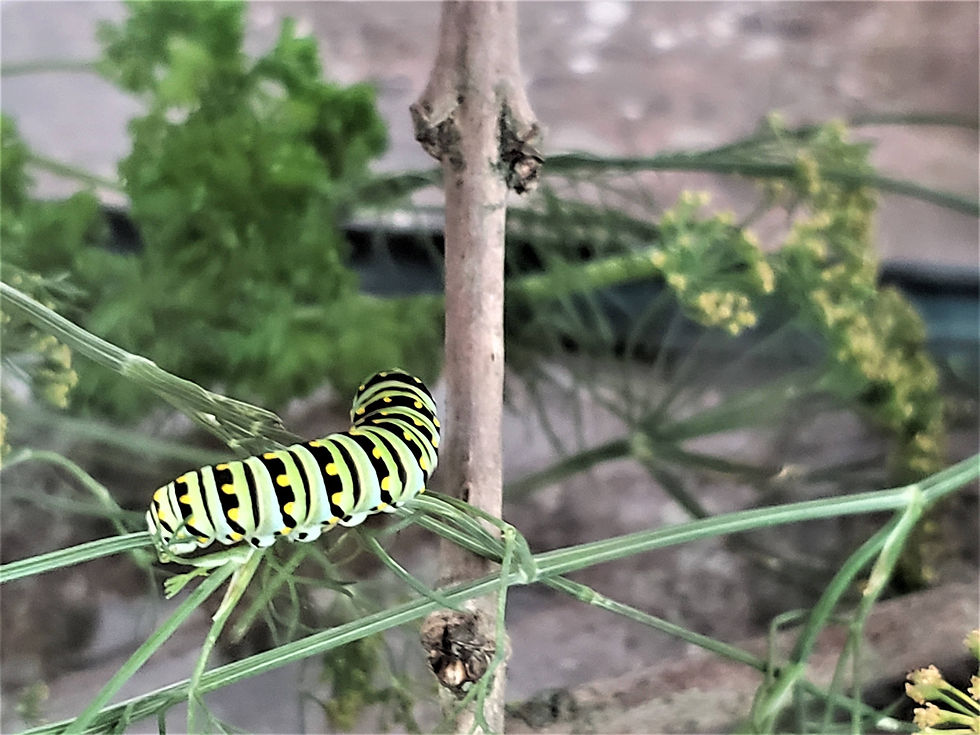Swallowtail Butterflies
- Waterloo Gardeners
- May 31, 2023
- 3 min read
Alianna’s Caterpillars
by Dianne Wittig
photos @ Christine Wittig

In the summer of 2021, I planted dill in a large pot on my patio. While watering one day, I noticed five green caterpillars climbing amongst the branches. Each caterpillar was two centimetres in length and marked with a thin black band and yellow-orange spots on each segment. This was the first time I had grown dill and I was surprised that it attracted “Monarch butterflies”.
I gently harvested each caterpillar and deposited them into a large jar with dill branches. I was certain my granddaughter, Alianna (age 4), would be delighted to have these creepy crawlies as pets. (Since age two, she had been bringing bugs and caterpillars home to her parents hoping to keep them as pets.) Watching these caterpillars turn into Monarch butterflies would be a good science project for her. Little did I know that I was to get a lesson in caterpillar identification.
My daughter-in-law, Christine, prepared a large empty aquarium home for the five caterpillars. Alianna gave each of them a name: Millimetre, Dillimetre, Dilly, Gherkin, and Pizza. The floor of the aquarium was quickly lined with paper towels that were refreshed frequently.
“What goes in, comes out” is true in the case of caterpillars; they eat continuously and excrete volumes.
The caterpillars were immediately given an ample supply of milkweed leaves to eat – which they
snubbed. Confused by their disinterest, Christine did a computer search and discovered these were Black Swallowtail caterpillars and they eat dill, parsley, fennel, Queen Anne’s Lace and carrot tops. Of this list, Alianna’s caterpillars preferred the dill.

All went well within the boundaries of their new indoor home, although one caterpillar did escape briefly to be discovered crawling along the top perimeter of the aquarium. It was quickly returned to the prepared habitat and a new safe mesh cover was placed over top. It only took three weeks for the caterpillars to grow to their mature size of 5 cm whereupon one of them attached itself by two threads on the underside of a branch. Now positioned in a “J” shape, that caterpillar’s brilliant green skin turned to a brown dried-leaf-looking chrysalis in a period of one day.

At first, Alianna and her family thought the caterpillar had died. They considered letting the remaining caterpillars go, but the rest quickly followed suit hanging under a twig and turning into brown chrysalises. They remained in this state for 14 or more days. Then, one morning, it was discovered that two of the butterflies had emerged from their chrysalises and were flapping their wings, strengthening them for flight. The remaining three butterflies emerged the next day.
This caused a happy celebration amongst family members. After many weeks of observation, Millimetre, Dillimetre, Dilly, Gherkin and Pizza had cycled into brilliantly marked butterflies. All were released to the green belt behind the family home. In addition, everyone now knew the difference between a Monarch caterpillar and a Black Swallowtail caterpillar.
The following information was taken from Butterflies at home website.
Black Swallowtail Life Cycle: Overview and Timings
Stage Typical Duration
Egg stage Generally 4 to 10 days, depending on temperature and host plant
Caterpillar (larval) stage 3 to 4 weeks
Chrysalis (pupal) stage 10 to 20 days (except for overwintering pupae)
Adult butterfly stage 6 to 14 days
Identification of Male and Female Black Swallowtail Butterflies
The male features a large row of yellow coloured spots across the middle of its wings. The female has smaller spots, but a larger area of blue scales on the lower wings. Both sexes have two prominent orange eyespots on their hind wings close to their tails.
Three chrysalises hang suspended from a branch. Two recently emerged Black Swallowtail butterflies, wings folded exposing their brilliant undersides, soon ready for first flight.
What’s the Difference?

Black Swallowtail caterpillar
Green to yellowish green in colour with irregular black bands dotted with orange or yellow spots
Feed on Queen Anne’s Lace, carrot, dill, parsley, fennel and celery from end of June to mid-September

Monarch caterpillar
Has bands of white, yellow and black with a pair of black filaments at its head and tail
Feed on milkweed leaves
If you would like to share your gardening adventures with us, please email waterloogardeners@gmail.com ATT: BLOG CONSIDERATION.






















Comments